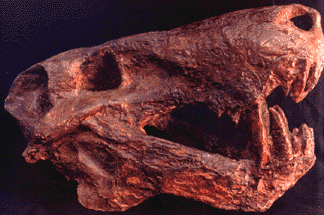
Inostrancevia alexandri -Amalitzky, 1922- skeleton
Therapsida:
Theriodontia: Inostranceviidae
Locality: Sokolki, Malaya
Severnaya Dvina River, Arkhangelsk Region, northern European Russia
Age: Late
Permian, 250 million years ago
Meaning of name: Named in honor of A. Inostrantzev,
Russian geologist
Size: The size of large tiger
The
most dangerous land predators of that time were huge gorgonopsid theriodonts.
The
largest of these was Inostrancevia. They not only ran quickly but also swam well.
Their
huge saber-fangs of about 12 centimeters in length permitted them to assault
thick-skinned
pareiasaurs and dicynodonts. Lateral teeth were small and weak
in the
upper jaw with none at all in the lower one. Prey was broken up with the
help of strong
incisors and inasmuch as chewing was impossible whole pieces were
swallowed.
This
specimen is represented by a skeleton of a large sabre-toothed theriodont reptile.
The
gracile nature of this animal and the development of many kinds of
teeth marks
it as a therapsid, an advanced carnivorous mammal-like reptile.
By this stage
of evolution of mammal-like reptiles, the limbs are tucked
more nearly under the
body as in living mammals.
This is in contrast to more primitive reptiles that
have the upper part of the
limbs projecting outward, rather than downward, thus
in sprawling stance,
similar toTitanophoneus potens.






